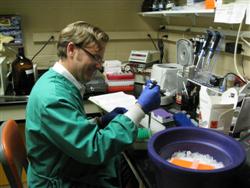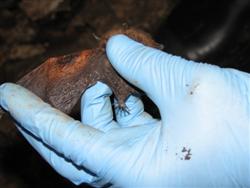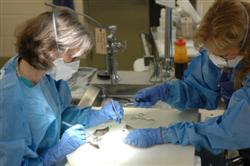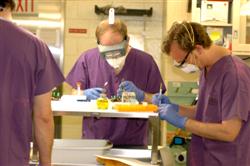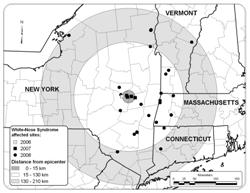A previously undescribed, cold-loving fungus has been linked to white-nose syndrome, a condition associated with the deaths of over 100,000 hibernating bats in the northeastern United States. The findings are published in this week's issue of Science.
The probable cause of these bat deaths has puzzled researchers and resource managers urgently trying to understand why the bats were dying in such unprecedented numbers. Since the winter of 2006-07, bat declines at many surveyed hibernation caves exceeded 75 percent.
The fungus—a white, powdery-looking organism—is commonly found on the muzzles, ears and wings of afflicted dead and dying bats, though researchers have not yet determined that it is the only factor causing bats to die. Most of the bats are also emaciated, and some of them leave their hibernacula—winter caves where they hibernate—to seek food that they will not find in winter.
| Related Podcasts |

What's Killing the Bats in the Northeast? |
Geomyces are a group of fungi that live in soil, water and air and are capable of growing and reproducing at refrigerator-level temperatures. Although the new fungus is a close genetic relative of known Geomyces, it does not look like a typical member of this group under the microscope. "We found that this fungus had colonized the skin of 90 percent of the bats we analyzed from all the states affected by white-nose syndrome," Blehert said.
Researchers don't know yet if white-nose syndrome emerged because this newly identified fungus was introduced into caves or whether the fungus already existed in caves and began infecting bats after they were already weakened from some other cause. "This fungus may have been recently introduced to bat hibernation caves and, if so, human and animal movements among these caves are causes that need to be considered,"says Blehert. "Data show the occurrence of white-nose syndrome radiating outward from the site of its first appearance, and genetic identity among fungal isolates from distant caves argues for a recent introduction of this microbe. Before the identification of white-nose syndrome, mass mortality events in bats as a result of disease were very rare."
WNS was first seen in New York during the winter of 2006. Since then, populations of cave-hibernating bats have been drastically declining in New York, Vermont, Massachusetts and Connecticut. Affected species include little brown bats, northern bats, tricolored bats, Indiana bats, small-footed myotis and big brown bats.
Worldwide, bats play critical ecological roles in insect control, plant pollination and seed dissemination, and the decline of North American bat populations would likely have far-reaching ecological consequences, the researchers wrote. They noted that parallels can be drawn between the threat posed by WNS and chytridiomycosis, a lethal fungal skin infection that has recently caused precipitous global amphibian population declines.
"Right now," said Blehert, "we are uncertain about the long-term effects of white-nose syndrome on North American bats, but we are quite concerned about future effects on bat populations wherever environmental conditions are conducive to growth of the fungus. To manage and perhaps halt this disease, we have to first better understand it."
Websites for additional information:


 Products
Products